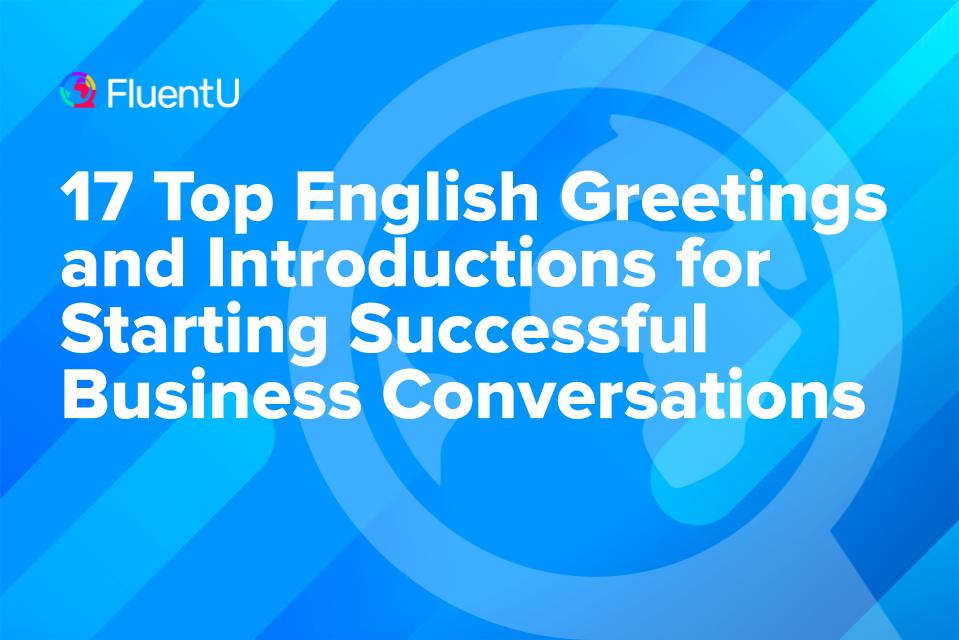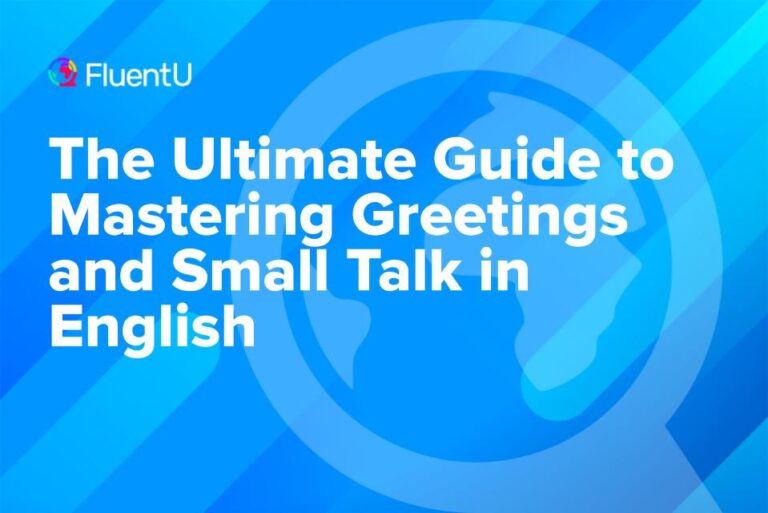17 Top English Greetings and Introductions for Starting Successful Business Conversations

Business interactions can hinge on just a few key moments.
When you meet someone new, you barely know anything about them–but your mind makes snap judgments right away.
The person you’re talking to could be a potential customer, a peer from the same industry, an investor, or a potentially useful contact. Whoever they are, making a good first impression will get them to notice you.
This might involve putting yourself forward and doing English greetings and introductions–even if English is your second language. In this guide, we’ll be taking a look at English vocabulary that will help you meet new people and introduce yourself with ease in a professional setting.
Making a Good First Impression
Instead of struggling with what to say on the spot, you’ll feel more confident when you prepare before jumping into conversations:
Think about how you’ll describe yourself
You can’t anticipate what exactly people will ask you about, but you can plan out how you’ll describe yourself. You’ll almost always have to mention the following details:
- Your current role and the kind of work that you do
- The company that you’re working for or your business
- Your industry
Aside from these, list down other noteworthy facts about yourself that you can bring up.
For example, if you’re attending an industry event, maybe you have a project that you pulled off successfully, or you have specific interests that you’d like to connect with people over. On the other hand, when you’re mingling with potential customers or talking to investors, you’d need to deliver a pre-planned pitch about your product or service.
Research who you’re meeting
Since you’ll be meeting people for the first time, don’t go into it blind–look up who will be attending. You’ll have a different approach when introducing yourself to executives compared to when you’re about to hold a mentoring session with junior colleagues.
When there’s at least one person whose attention you want to catch, you can even do your research on that person. Get familiar with their body of work along with their mindset. This information is easy to find because you can check out their website, LinkedIn, or any online articles written about them. This might take less than ten minutes to do, but you’ll have a better idea of how to strike up a conversation with them.
Practice your body language
Before you even start speaking, people can already tell a lot from your body language and how you present yourself. As with any professional setting, your choice of dress will be one of the first things that people will see. Even when people aren’t observing you on purpose, your body language will also have a huge influence.
Top English Phrases for Greetings and Introductions
Before you can talk about business matters, you might have to spend time first on making greetings and introductions. We’ve compiled some essential English phrases for introducing yourself or others. Meeting people doesn’t have to be intimidating, especially since the greetings and sentence structures listed below pop up frequently!
Greetings
Start with a greeting that sounds friendly yet professional.
1. Hello, [name]!
This is one of the most standard greetings in English, and it’s probably one of the first phrases that you’ve learned. With “hello,” you can greet most people–an old friend, a colleague you’ve barely talked to, or a stranger that you simply need to ask for directions from. A usual alternative to it is “hi.” Although “hello” and “hi” are interchangeable in most situations, “hello” is slightly more formal.
2. Good morning, everyone. It’s a pleasure to be here.
You can say this when you’re talking to a group of people at a specific event. Depending on the time of the day, “good morning” is replaceable with “good afternoon” or “good evening.”
This phrase could work well when you’re at a meeting with stakeholders, having dinner with clients, or speaking up at a group video call. Because of its formal tone, you can reserve this phrase for people that you don’t meet with frequently–usually on a special occasion.
3. How’s it going?
Out of the three greetings here, this is the most casual. It’s also a direct invitation to small talk–you’re essentially asking the other person how they are, which can be a great ice-breaker.
Because it comes off as more familiar than the other greetings above, native English speakers say this when they’re talking to an acquaintance or to a group where they already know some of the people.
Greetings to Avoid
It’s also important to know which greetings to avoid. Some greetings can be way too casual. You could use them with people that you’re close to, but not with someone you’ve barely met:
- Hey, [name]!
- Yo! What’s up?
- How’s life?
- Look who it is!
- Looking good!
Introducing Yourself
After greeting other people to catch their attention, the next step is to make introductions.
If you’re introducing yourself, the simplest introduction that you can make is to mention your name: “I’m [name]” or “My name is [name].” However, in a business setting, it’s expected that you’ll reveal additional information about yourself and your work using these phrases:
4. I’m [name] from [company].
When you have to make a quick introduction to people from other companies, you can say your name followed by which company you’re from.
This is ideal in events where people already have an idea of your role or specialization, such as during conferences or industry meetups.
Example:
- I’m Jennifer from GRH Software Solutions.
5. My name is [name]. I’m a [role].
Instead of stating your company, you can also just describe your role or job.
If you attend a workshop where the attendees are diverse, you might choose to emphasize your role instead since some people might not be working at a specific company. Freelancers or consultants also tend to default to this introduction.
Example:
- My name is Lance. I’m a data analyst.
6. I’m [name]. I work as a [role] at [company].
Sometimes you have to make a complete introduction–maybe you’re reaching out to a client or trying to get your work noticed by someone specific.
This type of statement is more formal, and it prompts the other person to introduce themselves in a similar way too. Depending on the situation, you can follow this up with “It’s nice to meet you.”
Example:
- I’m Cynthia. I work as a logistics manager at Mizuri Group.
Introducing Other People
You might find yourself having to introduce two or more people that you know to each other. There aren’t any strict rules about this, but it’s generally polite to introduce the lower-ranking person to the higher-ranking person in a business setting. This is usually easy to figure out:
- Look at people’s job titles. Regardless of whether they’re in the same company, a senior manager would have higher ranking than a junior employee, so you would introduce the junior employee to the senior manager.
- If their job titles seem to have a similar rank, make introductions to the person that you’re closer to. For example, you’d introduce a distant colleague to someone in your team that you work with every day.
- For clients, you would generally introduce the client to your colleague since you’re more familiar with your colleague.
Here are additional phrases that will get the conversation going quickly:
7. [Person A], this is [Person B].
For a straightforward introduction, this is the statement that you would go for. You can pause after this statement because this is taken as a hint for either Person A or Person B to exchange pleasantries or to mention information about themselves.
Example:
- You: Arnold, this is Marcus.
Arnold: It’s nice to meet you, Marcus!
Marcus: Great to talk to you too, Arnold! [your name] mentioned that you’re working in tech.
8. [Person A], I’d like to introduce you to [Person B]. [Describe Person B]
When you’re introducing people for a specific purpose, you can use this statement. After mentioning the two people’s names, encourage them to start talking by explaining a common interest of theirs or the purpose behind your introduction.
Example:
- You: Hannah, I’d like to introduce you to Evelyn. She wants to know more about the pitch that you made this morning. Evelyn: I’ve actually been doing similar research, so I thought it might be great to compare notes with you on that.
Hannah: Sure, I’d love to!
9. [Person A], I don’t think you’ve met [Person B]. [Describe Person B]
There are occasions when only one person knows the other. A senior executive might not know a junior employee, or a participant might be familiar with the speaker’s name but the speaker hasn’t met them yet. You can make a smooth introduction using this statement.
Example:
- You: Julia, I don’t think you’ve met Harold Myers. He’s a financial trader at [insert bank].
Julia: Oh, I worked there before, but at a different location!
Harold: Yes, I enjoyed your talk because I found your company case studies relatable.
Breaking the Ice
With these sample phrases below, you can liven up the conversation as you turn to small talk:
10. We both went to [event]… Didn’t we?
You might have recognized the other person because you went to an event at the same time, but you’ve never been formally introduced to each other.
This statement can be very effective for small talk because you’re pointing out what you have in common. The conversation can then turn to your experience of the event, what the other person about it, or the reasons why both of you went to the event in the first place.
Example:
- We both went to that problem-solving workshop, didn’t we? I think I saw you there, but we didn’t get to talk.
11. Good to talk to you at last.
If you’ve heard about the other person before or you’ve seen each other but haven’t chatted, then this phrase can be an ice-breaker. It’s a polite way of expressing friendliness–you’re looking forward to talking to the other person. This is most commonly used between two colleagues who know about each other’s names because they work in the same company.
Example:
- Good to talk to you at last! We’ve been working a lot with other people from the design team.
12. Wow, look at [that view behind you]!
When you’ve never met the other person before and you barely know anything about them, starting a conversation can be more challenging. Here’s a classic: comment on your surroundings.
The person could be standing in front of a window, and you could point out the view behind them or make an observation about the room that you’re in. Food is also an effective conversation-opener–everyone almost always has something to say about it.
Example:
- Wow, look at that view behind you! It’s so scenic from up here.
13. Which projects have you been up to lately?
This conversation-opener comes off as more casual. For professional situations, you can ask about the other person’s projects specifically, rather than about their life as a whole. The other person could then either describe what they’re currently doing at work or maybe even mention a personal project of theirs that they’re passionate about.
Example:
- Which projects have you been up to lately? I’ve heard that everyone has been pretty busy in business development.
14. I’ve really been enjoying the new [TV show, football season, etc]… Has anyone seen it?
For kicking off small talk with a group, you can bring up a movie, TV series, app, or more–any form of entertainment that people in the group will be able to relate to. The larger the group, the trickier this can get because ideally, everyone will be able to jump in and contribute to the conversation.
You can also pull this off in one-to-one interactions. If the other person says they haven’t seen it, then redirect the conversation back to them and ask, “What have you been watching or reading lately?”
Example:
- I’ve really been enjoying this new comedy about restaurant owners. Since we’re all in the restaurant industry, has anyone seen it?
15. Really excited about the coming [event]. Anybody heard of it?
Aside from entertainment, events are another great small talk topic. You can talk about news or current events but also upcoming events that the other person might be interested in.
This works especially well when you know that you have common ground with the other person–maybe the event is a company mixer, or it’s a finance program that both of you would want to attend.
Example:
- Really excited about the coming jiu-jitsu classes they’re offering everyone on Thursdays. Anybody heard of it?
On to Business Matters
The small talk will wind down eventually, and you’ll have to get down to business and move on to your official agenda for the meeting. Since people can get absorbed in long conversations, you might have to signal the transition to business matters using certain English phrases:
16. Thanks for being here! What do you say we move into…
To make the transition less abrupt, start off by showing your appreciation for the person being present.
You can then phrase your next statement as a question: “What do you say we move into discussing our budget?” This sounds more polite because you’re expressing it as a suggestion rather than an order. People will naturally answer with “Sure!” or “Yes.”
Example:
- Thanks for being here! What do you say we move into going over our sales for this month?
17. That sounds fantastic, glad this [team / group] is connecting! How about we transition to…
This statement would come in handy for when you’re with a group where the conversation is already flowing. The first sentence sets a positive tone and encourages team collaboration. In turn, the second statement alerts people that you’re ready to switch to business mode and talk about more serious topics.
Example:
- That sounds fantastic, glad this team is connecting! How about we transition into giving our weekly updates?
Conclusion
Sometimes you might only have one chance to make a great first impression on a business contact. Or maybe you’re leading an important meeting, and there’s pressure on you to start it the right way. Since we meet so many new people all the time at work, being able to do greetings and introductions properly is a must-have skill.







